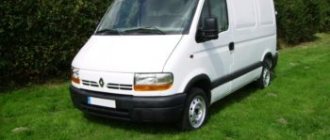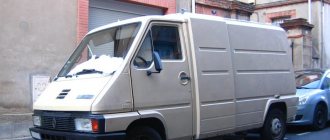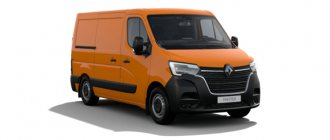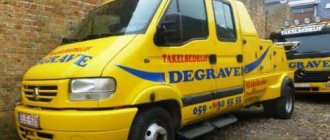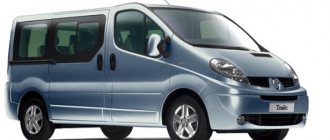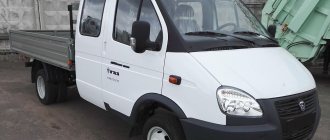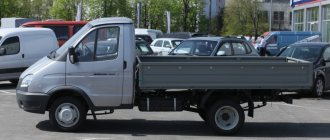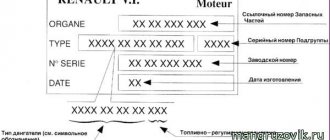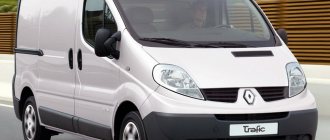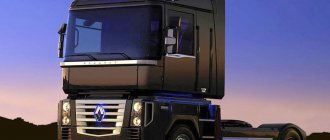Renault Master is a series of small cars produced by the French company Renault since 1980. The model is available in various body styles, wheelbases and heights. The third generation of the car is currently available. Earlier models were also sold under the name Vauxhall Movano and Opel Movano.
Renault Master refers to commercial trucks with a total weight of no more than 3.5 tons. Thanks to this, you can drive a car with a category “B” driver’s license.
The third generation of Renault Master appeared on the Russian market in 2010. However, due to consumer distrust of the manufacturer, the demand for these cars is relatively small. At the same time, the build quality and reliability of the design of the series models remains at a high level. Renault Master is adapted to bad roads and harsh winters, so it will be an excellent assistant for any owner.
PURPOSE
Since the start of production, the Renault Master has been available in various variations, including long wheelbase models. The most widespread are vans designed for transporting small volumes of cargo. The passenger version was used to transport people (17 people - European countries, 19 people - Russia). On-board variations and versions with special add-ons were also in demand.
Renault Master models with increased payload capacity were produced by the Renault Trucks division under the name Renault B (Renault Messenger and Renault Mascott).
It should be noted that the series has found wide application not only as a commercial vehicle, but also as a car for the family.
Overall dimensions, ground clearance
In order to maximize the functionality of the bodies, engineers presented several versions of the bodies, differing in length and height. There were also several options for the location of partitions inside the body.
The short wheelbase version was 5048 mm long and 2070 mm wide. The height of this modification ranged from 2290 to 2307 millimeters. The ground clearance was unchanged for any version and was 185 millimeters. In reviews of the Renault Master, owners indicate that this ground clearance is quite sufficient for most tasks.
A car with a medium wheelbase had a length of 6198 mm, and models with a long wheelbase had a length of 6848 mm. At the same time, the length of the wheelbase ranged from 3182 to 4332 millimeters. The turning radius ranges from 12.5 to 15.7 m.
The maximum load capacity of the Renault Master, depending on the body, could range from 909 to 1609 kilograms. In this case, the total curb weight was from 2800 to 4500 kg. The luggage compartment had a volume from 7800 to 15,800 liters.
First generation
The development of the first Renault Master took several years. As a result, production of the series began in 1980. The design of the model did not stand out in anything remarkable: a classic angular body for that time with a large black bumper and a radiator grille of the same color. A distinctive feature of the family was the unusual rounded door handles, reminiscent of Fiat Ritmo handles, and a side sliding door.
Until 1984, Renault Master 1 was equipped with 2.4-liter Fiat-Sofim 2445 cc diesel units, after which a 2.1-liter 2068 cc diesel engine was introduced into the design. For some modifications, gasoline engines of 2.2 and 2 liters were offered.
The release of the debut generation was carried out at the Renault plant; subsequently, production was transferred to the SoVAB plant, located in Batilly (France).
The first generation had a lot of competitors. Moreover, they included another model of the company – Renault Trafic. Demand for the series grew slowly, but the large cargo compartment and new market trends allowed the model to sell in a fairly large circulation. The first Renault Master was inferior to most competitors, but managed to stay on the market for almost 17 years.
In parallel with the classic versions, the Renault Trucks division produced modifications with greater payload capacity. The first representative of the special series was the B70 model with a 70-horsepower diesel engine. In 1982, production of the Renault B80 with an 80-horsepower gasoline unit began. The cars were small trucks with a body from Renault Master 1, but on a rear-wheel drive chassis with the optional addition of dual rear wheels. Subsequently, the Renault B model line expanded to include versions with more powerful units with intercooler and turbocharging. In 1993, the family was updated, receiving a revised grille and a new name - Renault Messenger.
Second generation
The second generation was announced as a joint project between Renault and Nissan. The main developer was considered the French brand, which presented the new Renault Master in 1997. Almost simultaneously, the debut of Opel Movano (Vauxhall Movano) and Nissan Interstar took place. The new product turned out to be very successful and a year later received the title “Best Truck of the Year.”
The design of the Renault Master has been completely revised in comparison with the first generation. The model received a sliding design, and the developers completely copied some elements from the Fiat Strada and Fiat Ritmo, which were very popular at that time. The European appearance with rounded hood lines, a large bumper and headlights and an enlarged brand logo added to the car's attractiveness.
The line of engines was represented by Renault G-Type, Nissan YD and Sofim 8140 diesel engines of various sizes (2.2, 2.5 and 2.8 liters). The engines were complemented by one of 3 types of transmissions: 6-speed automatic, 5-speed manual or 6-speed manual.
In 2003, the series underwent a global facelift, which added similarities to Renault Traffic. As part of the update, the contours of the body became more rounded, and the area of the headlights increased.
All second-generation versions were assembled in northeastern France.
Renault Trucks, in turn, began production of the new Renault Mascott. The rear-wheel drive version of Renault Master with increased load capacity was produced in 1999-2010. The special version was an intermediate link between the light-duty Renault Master and the heavy Renault Midlum. Consumers were offered 2 modifications with 122- and 162-horsepower diesel engines (5- and 6-speed manual transmission, respectively). The popular series also received alternative names used in other countries: Renault Master Pro, Renault Master, Renault Maxi, Renault Master LDT and Renault Propulsion.
Third generation
In the spring of 2010, the third generation Renault Master premiered. The model was also produced under several names (Opel Movano, Nissan NV400 and Vauxhall Movano). The design of the series has changed dramatically, but has retained recognizable features. In the front part, elongated teardrop-shaped headlights, a large bumper and an interesting radiator grille appeared. The appearance of the car has become more solid and modern, and the ability to choose the design of the side (classic or glazed version) added individuality. The dimensions of the Renault Master have increased (the useful volume has increased significantly). The design of the thresholds has been optimized for loading and unloading.
Cars in the series received 2.3-liter diesel engines with a power of 100-150 hp.
In 2016, the French brand introduced the Renault Master X-Track. The new model was distinguished from the classic version by underbody protection, a limited-slip differential and increased ground clearance. An all-wheel drive version of the Renault Master with a 4x4 wheel arrangement also appeared.
Production of the special version of the Renault Mascott as a separate product has ceased. The Renault Trucks division was rebuilt to produce the third generation Renault Master in the format of a self-propelled chassis with a payload capacity of up to 2.5 tons.
Technical characteristics of the Renault MasterII L2h3 2.5 TD (FD (2006))
Technical specifications Renault MasterII L2h3 2.5 TD
Renault Master II L2h3 2.5 TD
In 2006, a new version of the Renault Master was released with a modified exterior and interior. Renault Master cargo vans offer a wide selection of modifications of the new Master: 3 length options and 3 height options. Various accessories make loading, transporting and unloading luggage easier. A very low threshold facilitates access to the rectangular cargo compartment, and numerous securing rings help securely secure the cargo being transported. Only at first glance, Renault Master looks like an ordinary van, so familiar to our eyes. But once you get behind the wheel, you will immediately understand that it is special. Because only Renault Master is equipped with an engine that has no analogues in terms of power and efficiency. Only Renault Master is equipped with so many electronic options. Only Renault Master is capable of driving on any road, in any weather, with the maximum possible load, while providing the driver with maximum comfort. And, of course, a few words about the cargo compartment. You will have to rack your brains over its execution, fortunately there are a lot of options. Choose a glazed or solid rear; doors that swing open to an angle of 180 or 270, sliding doors on one or two sides and much more.
The automobile catalog contains a description, technical characteristics and photographs of the Renault MasterII L2h3 2.5 TD.
Sale of used Renault Master cars
Reviews from Renault car owners
- 30.09.2010
Shchepkin Vitaly
Author's rating
Objectivity
Greetings to fans of the French automobile industry! A week ago I picked up my new Fluence from the Avantaim car dealership on Dmitry Ulyanov, in the color “Eclipse Gray”, expression 1.6 equipment (16th casting + advanced music). I decided to buy the car from an official Renault dealer. There are a lot of emotions, and positive ones still prevail. I'll tell you about my impressions after a short acquaintance. The car appears to be a class above from the outside. It looks very impressive - streamlined shape, soft lines. There is nothing superfluous. I liked her more in life than in the photographs I saw. ...
more details
- 03.12.2008
gene2_03122008
Author's rating
Objectivity
Renault car symbol is just a fairy tale. I was choosing, searching, reading about the Kia Spectrum and other cars, everything was leaking somewhere, the steering wheel was moving, etc. And I settled on the Renault Symbol and I don’t feel like it, no problems. The car is excellent for Moscow and the Moscow region. In the morning I sat down and drove off and you don’t think that it will leak somewhere or won’t start. You can easily park and get through where other cars would have a problem. The car is simply ideal for driving around Moscow.
more details
- 20.03.2008
Father_20032008
Author's rating
Objectivity
A good car for family and work. A combination of spartan comfort and working endurance. Good cross-country ability and easy handling. Easy to maintain and an average cost of spare parts.
more details
www.autonet.ru
SPECIFICATIONS
The overall dimensions and weight characteristics of the Renault Master largely depend on the modification and configuration.
Dimensions (van):
- length (short, medium, long, extra-long base) – 5048/5548/6198/6848 mm;
- width – 2070 mm;
- height – 2294-2797 mm;
- ground clearance – 169-186 mm;
- front track – 1750 mm;
- rear track – 1730 mm;
- wheelbase – 3182/3682/4332 mm;
- turning diameter – 12500-15700 mm.
Other characteristics (van):
- curb weight – 1922-2395 kg;
- maximum weight – 3500 kg;
- load capacity – 1105-1578 kg;
- trunk volume – 7800-22000 l;
- door opening angle – 270 degrees.
Fuel consumption:
- on the highway - 7.1-9 l/100 km;
- in the city - 9.4-9.8 l/100 km;
- combined cycle - 8-9.3 l/100 km.
All Renault Master modifications are equipped with a 100 liter fuel tank.
Description of technical parameters
The technical characteristics of Renault Master allow the car to be popular among consumers. It is quite competitive in the commercial vehicle market, reliable and easy to maintain.
The Renault Master is characterized by:
- dimensions: 5.548 x 2.07 x 2.486 m;
- ground clearance: 18.5 cm;
- wheelbase: 3.682 m;
- loading height: 0.548 m;
- turning radius: 7.05 m;
- load capacity: 1.498 kg;
- cargo compartment size: 3.083 x 1.765 x 1.894 m;
- car body volume: 10.3 m3;
- number of seats Renault Master: 3;
- tires: 225/65 R16.
Overall dimensions of Renault Master III
ENGINE
The Renault Master is equipped with 2.3-liter engines of varying power with direct fuel injection. The units are a further development of the Nissan MR engine line, but are used exclusively on Renault Master and its “twins”. The engines are distinguished by their compliance with Euro-4 environmental standards and acceptable fuel consumption. The engines perform well in severe frost conditions. Variations with the Common Rail system or standard versions without it are available.
In terms of design, the various types of Renault Master engines are practically the same and are an in-line “four” running on diesel fuel.
Unit characteristics:
- rated power – 100 hp, maximum torque – 248 Nm;
- rated power – 125 hp, maximum torque – 310 Nm;
- rated power – 150 hp, maximum torque – 350 Nm.
Fuel consumption data
The car's engine runs on diesel fuel. The car is quite economical. In the urban cycle, fuel consumption is 9.6 liters per 100 km, in the suburban cycle – 7.3 liters. Combined driving requires 8.1 liters per 100 km. Renault Master is equipped with a fuel tank that holds 100 liters, which allows you to cover long distances without refueling.
Renault Master fuel tank
DEVICE
The commercial line of Renault Master especially clearly reflects the philosophy of the French company. The body of the series is both stylish and practical. Protective elements on the side and a large bumper increase safety, while an interesting radiator grille and regular lines add attractiveness. Renault Master is assembled in France, which guarantees a high level of quality. The car has low operating costs. The decorative coating of the body and durable external elements ensure the durability of the structure (it is no coincidence that the warranty against through corrosion on the series model is 6 years).
Chassis
The front suspension of Renault Master is made using an upper reaction rod connecting 2 levers. This design is characterized by a wide profile, making it easier to control the car on wet roads. The front part is equipped with an independent McPherson-type suspension. The rear suspension, which is dependent, uses a trailing arm.
The latest generation of Renault Master is equipped with a chassis and suspension that provide high directional stability. The wide track provides additional control. At the same time, stable operation of the suspension is maintained under any load.
Salon
The latest generation of Renault Master has an incredibly well-thought-out internal arrangement. The cabin has countless compartments and storage for various items. Small niches and pockets allow you to place documents and small items inside. Visibility is excellent through the windshield and sides.
Special conditions have been created for the driver in the Renault Master III. The steering wheel can be adjusted in height, choosing the optimal position. The driver's seat, regardless of the person's constitution, effectively dampens vibrations and vibrations, allowing you to enjoy the movement and not feel small bumps or speed bumps. Lumbar support and height adjustment are available in the basic version. The gear shift lever has been moved from the floor to the dashboard, which simplifies the process of selecting speed. Hydraulic power steering ensures smooth and easy turning.
Everything inside is lined with hard plastic. Extraneous sounds are practically inaudible. The series occupies one of the leading places in terms of protection level. Seat belts, airbags and special assistants provide maximum protection in the event of a collision or critical situation.
Renault Master is made of very high quality and, in terms of equipment, is more reminiscent of an expensive truck than an ordinary van intended for short-distance travel.
Safety
Regardless of the drive type and modification, Renault Master 2022 has a whole set of systems that provide complete control and safety. Electronic technology Hill Start Assist. After the owner releases the brake pedal, Renault MASTER will remain standing in place for several seconds. The technology helps prevent the car from rolling away when parking or stopping on an incline.
ESP technology helps insure the owner in case of loss of controllability and facilitates cornering at increased speeds. Thanks to the anti-lock braking system (ABS), it is possible to maintain high vehicle controllability during emergency braking. Also for safety, the Renault Master III has enhanced traction. It helps maintain control of the road surface during difficult conditions such as mud, snow or sand.
The system detects the wheel that is slipping and supplies the necessary torque to the drive wheels. At night, the driver will be assisted by additional cornering lights. Renault Master received a high level of safety even at night. With the help of additional headlights that turn on when you turn the steering wheel, an additional area of the road is illuminated.
A blind spot viewing mirror is also provided. It is installed in the passenger's visor. It helps to control the situation during a complex maneuver. For an additional cost, you can install the Security package. As a separate option, a side airbag for the owner and a front airbag for the passenger are installed from the factory.
If you plan to use a trailer, then the trailer sway assist system will come to the rescue. When the system detects a dangerous amplitude of body sway, it can limit the fuel supply to the power unit and begin to brake the wheels. To increase safety, you can use a differential lock.
When road conditions are less than ideal, differential locking on Renault Master rear-wheel drive models adds additional reliability and safety to the van.
